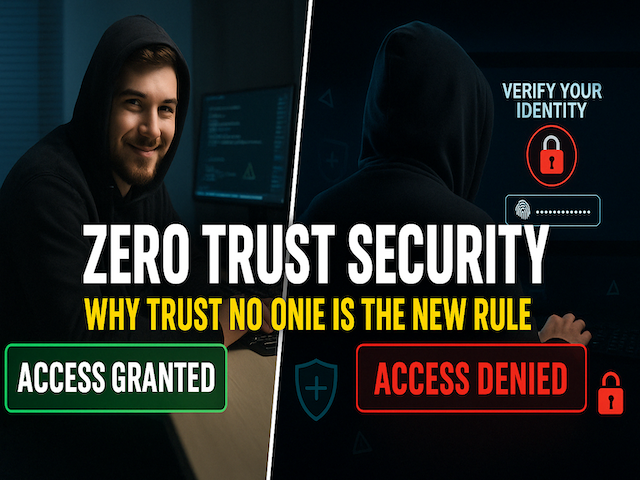4 Reasons Zero Trust Security Model Is Better Than Traditional Security

Cyber attacks evolve by the minute, and traditional security measures no longer cut it. The days of "trust everything inside the network" are gone. It's easy for hackers to bypass all that. That's where the Zero Trust Security Model comes in — a modern model that assumes no one and nothing is trustworthy by default, even though they're in your network.
In this blog post, we’ll break down the Zero Trust model in simple terms, why it’s important, how it works, and how organizations are implementing it today.
Prefer watching instead of reading? Here’s a quick video guide
What is the Zero Trust Security Model?
Zero Trust is a cybersecurity framework that says:
“Never trust, always verify.”
It is a requirement that every user, device, and application needs to verify their identity and legitimacy every time they try to access a system or data — wherever they are located (inside or outside the network).
Imagine a bank that doesn't simply let anyone waltz in and open the vault, even if they work there. Instead, they continuously check IDs, monitor behavior, and limit access to just what's needed. That's the principle of Zero Trust.
Why Legacy Security Doesn't Work
Most legacy networks employ a "castle-and-moat" approach:
- Fortify the perimeter (firewalls, VPNs).
- Assume everything inside is safe and trusted.
But today:
- Employees are working remotely.
- Cloud applications are accessed anywhere.
- Devices are mobile and personal.
- Attackers can get in the network very easily through phishing, weak passwords, or misconfigurations.
After getting in, attackers have free movement among systems. This creates massive data breaches.
Real-Life Example:
The 2013 Target data breach came about when attackers entered through a third-party vendor and moved laterally within the network to reach payment systems. Zero Trust would have prevented this.
Chief Principles of Zero Trust
Let us learn the building blocks of the Zero Trust strategy:
Verify Explicitly
Authenticate and authorize based on all available data — including user identity, location, device health, and behavior.
Example: Mere entry of a valid password won't be enough. The system may ask for two-factor authentication (2FA), check if the device is secure, and verify your location.
Use Least Privilege Access
Give users and devices the least privilege they need to accomplish their work.
Example: A marketing employee does not need access to financial databases. Limiting access restricts harm if their account is compromised.
Assume Breach
Always presume that an attacker has already compromised your system. This means:
- Network segmentation (micro-segmentation)
- Monitoring traffic
- Suspicious activity detection at high speed
Example: When a user is logging in from two different countries within minutes, that's suspicious.
How Does Zero Trust Work?
Implementing Zero Trust is not a process of buying one tool — it's a strategy with multiple technologies and practices. Here's how it typically works:
Robust Identity Authentication
- Implement multi-factor authentication (MFA)
- Enforce password-strong or passwordless login
- Use Single Sign-On (SSO)
Device Security
- Ensure devices are secure prior to granting access
- Use endpoint detection and response (EDR)
- Maintain an up-to-date inventory of all devices
Network Segmentation
- Divide your network into small, trusted segments
- Block or limit communication between systems
Ongoing Monitoring
- Monitor user and device activity in real time
- Use alerts for suspicious behavior
- Use AI/ML for threat detection
Data Protection
- Encrypt data in transit and at rest
- Use data loss prevention (DLP) software
- Use access control on sensitive documents
Zero Trust Architecture (ZTA)
The Zero Trust Architecture is a template or blueprint that consolidates all the controls discussed above. It typically includes:
- Identity Provider (IdP): Authenticates users and devices
- Policy Engine: Makes policy-based decisions regarding whether or not access is permitted
- Policy Enforcement Point (PEP): Enforces those decisions
- Monitoring System: Continuously monitors activity
This architecture allows businesses to apply policies dynamically, instead of statically through access lists.
Benefits of Zero Trust
The following are the biggest advantages of using a Zero Trust solution:
- Reduces Attack Surface: Attackers can't move around freely between systems, limiting damage.
- Protects Remote Work: Employees can work anywhere, on any device, safely.
- Improves Visibility: You know who did what, when, and how — useful for audits and compliance.
- Enhances Compliance: Helps with compliance with data protection regulations like GDPR, HIPAA, and ISO 27001.
Zero Trust Challenges
Despite being robust, Zero Trust is not without challenges:
- Complexity: Setting policies and systems up can be tricky.
- Cost: Entails investment in tools, training staff, and upgrading systems.
- Cultural Resistance: Staff may be irritated by additional checks.
The key to implementing Zero Trust is to do it incrementally — start small, pilot, and scale up.
Starting to Roll Out Zero Trust
Ready to join the Zero Trust bandwagon in your company? Here's how to do it step by step:
- Assess your current environment: Define users, devices, applications, and data flow.
- Identify key assets: Start with the most sensitive data and systems.
- Apply strong identity controls: Enforce MFA, SSO, and demand identity authentication everywhere.
- Secure devices and endpoints: Utilize endpoint protection software, device health checks, and mobile device management.
- Set access policies: Define who gets to see what, when, and how.
- Scan and refine: Periodically scan logs, refine policies, and take advantage of threat intelligence.
Last Thoughts
Zero Trust Security Model is not a trend — it's where security is headed. With increased cloud utilization, remote employees, and sophisticated cyberattacks, perimeter security just isn't sufficient anymore.
Zero Trust helps organizations stay secure by assuming nothing and verifying everything. Whether you’re a small business, a large enterprise, or even a student setting up a lab environment — learning and applying Zero Trust principles will make your systems much harder to hack.
If you’re starting your cybersecurity journey or working on strengthening your company’s defenses, adopting Zero Trust is a smart move.




